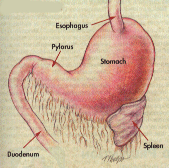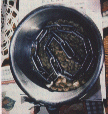Bloat is very common in many large breeds. It's an owners nightmare
returning home or waking up to find a beloved pet has died of gastric dilatation-volvulus,
or bloat and torsion as it is more commonly known, an agonizing condition
that can strike suddenly and fatally. Sadly for many owners this nightmare
has become a traumatic reality. Dogs that succumb to the condition suffer
immense pain and an obscenely distended abdomen that can grow to as large
as a beach ball.
 Normal Stomach
Normal Stomach
|
 Stomach with Gastric Dilatation-Volvulus
Or Bloat / Torsion
Stomach with Gastric Dilatation-Volvulus
Or Bloat / Torsion
|
Bloat is a condition in which there is a rapid accumulation
of air in the stomach causing dilatation. Volvulus, or torsion, occurs
when the dilated stomach twist, cutting off contact with the esophagus
at one end and the small intestine at the other. This effectively isolates
the stomach and traps the air. The very enlarged, twisted stomach puts
pressure on the blood vessels, often twisting them in the abdominal cavity
and thus impairing blood flow back to the heart. Because the heart receives
an insufficient amount of blood to pump, blood flow decreases to the rest
of the body. With this, there is the fairly acute onset the death of the
tissues that are deprived of oxygen, including the stomach wall itself,
which rapidly undergoes necrosis.
The early signs of bloat include discomfort. The dog paces or
repeatedly gets up and then lies back down. There also is excessive
salivation, panting and unsuccessful attempts to vomit. As the condition
worsens, the abdomen distends in most - But not all - dogs and feels
taut like a drum. Shock follows (i.e., pale gums, weakness, shallow pulse,
cool extremities, ect.) Often, dogs then go into a coma, and death is the
ultimate outcome if they are untreated.
It tends to occur with dogs that like to eat there dog food
quickly and gulp excess air.
Some owners place a heavy chain in the food bowl.
Feeding small meals 2-3 times a day not shorting the amount
they eat in total, but the amount they eat at one feeding.
|

|
|



